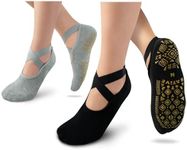Buying Guide for the Best Grip Socks For Pilates
Choosing the right grip socks for Pilates can make a big difference in your comfort, safety, and performance during your workouts. Grip socks are designed to provide traction, prevent slipping, and offer a hygienic barrier between your feet and the studio floor or equipment. When shopping for grip socks, it's important to consider several key features that will help you find the best fit for your needs and preferences.Grip Pattern and CoverageThe grip pattern refers to the rubber or silicone dots or lines on the sole of the socks that provide traction. This is important because it helps prevent slipping on smooth studio floors or Pilates equipment, which can reduce the risk of injury. Some socks have full-sole coverage with grips, while others only have grips in certain areas like the ball and heel. If you want maximum stability, look for socks with full-sole grip. If you prefer a lighter feel or more flexibility, partial grip coverage might be enough. Think about how much movement and stability you need during your Pilates sessions to decide which grip pattern suits you best.
Material and BreathabilityThe material of grip socks affects comfort, moisture control, and durability. Common materials include cotton, synthetic blends, and bamboo. Cotton is soft and breathable but may retain moisture, while synthetic blends often wick away sweat and dry faster. Bamboo is naturally antibacterial and breathable. If you tend to sweat a lot or want socks that dry quickly, look for moisture-wicking materials. If you prioritize softness and natural fibers, cotton or bamboo might be better. Consider your personal comfort and how much you sweat during workouts when choosing the material.
Fit and ElasticityFit refers to how snugly the socks hug your feet, and elasticity is about how well they stretch and stay in place. A good fit is important to prevent the socks from bunching up or slipping off during movement. Some socks have added elastic bands around the arch or ankle for extra support. If you have narrow or wide feet, look for socks that offer a range of sizes or have extra stretch. Try to choose socks that feel secure but not too tight, so you can move comfortably without distractions.
Toe DesignGrip socks come in two main toe designs: closed-toe and open-toe (sometimes called toeless). Closed-toe socks cover all your toes like regular socks, while open-toe socks leave your toes exposed. Closed-toe designs offer more warmth and protection, while open-toe designs can give you a better feel for the floor and more freedom of movement. If you like the sensation of being barefoot or want more toe flexibility, open-toe might be best. If you prefer more coverage or tend to get cold feet, closed-toe is a good choice.
Height and StyleThe height of grip socks can range from no-show (just covering the foot) to ankle or even crew length. No-show socks are discreet and lightweight, while higher socks can offer more warmth and sometimes extra support around the ankle. Your choice depends on your personal style, the temperature of your workout space, and whether you want extra ankle coverage. Pick the height that feels most comfortable and practical for your Pilates routine.
Washability and DurabilitySince grip socks are used during exercise, they need to be washed frequently. Durability refers to how well the socks hold up after repeated washing and use. Some materials and grip patterns last longer than others. If you plan to use your socks often, look for ones that are machine washable and have reinforced stitching or high-quality grips that won’t peel off easily. Consider how much maintenance you’re willing to do and how often you’ll use the socks when thinking about durability.















